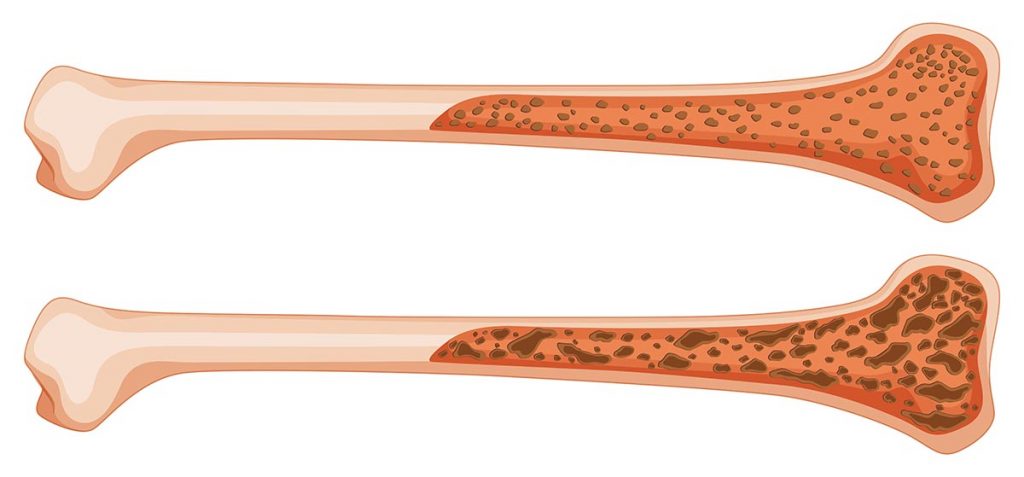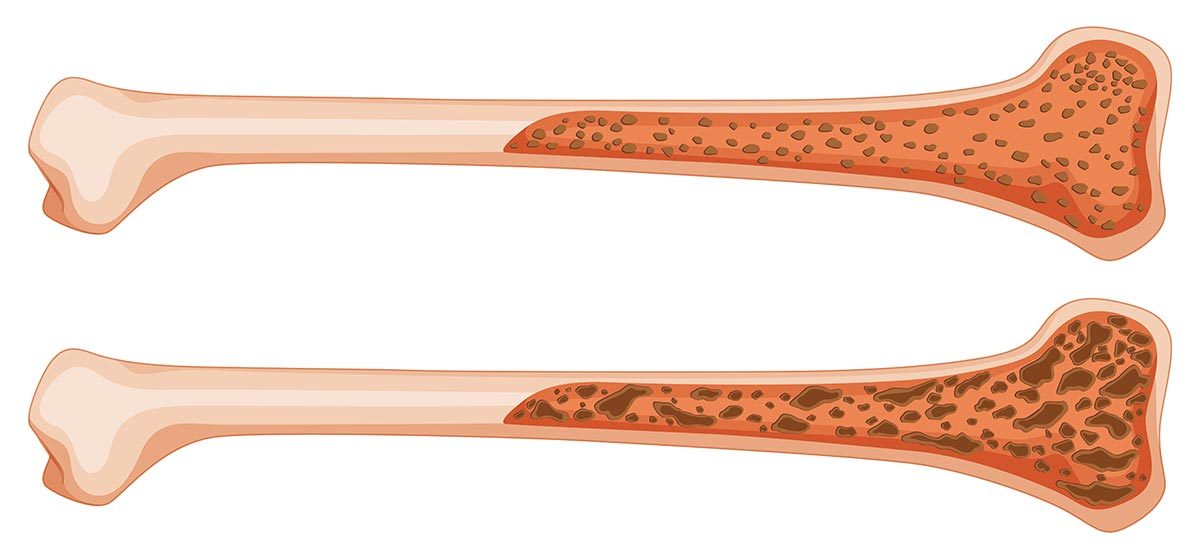Osteoporosis
![]()
Call (703) 520-1031 or use the form to send us your contacts.

Anyone can develop the disease called osteoporosis. The National Osteoporosis Foundation statistics indicate it is a common disease that afflicts nearly 10 million people in the United States. Another 44 million have low bone density, a precursor to developing full-blown osteoporosis. The following sections give an overview of the “silent disease” that frequently makes its presence known only after someone breaks a bone.
What is Osteoporosis?
Osteoporosis is a disease in which the bones become thin and porous. The low bone mass makes them susceptible to fractures. Bone is living tissue that is mostly soft collagen, a protein, and hard calcium phosphate, a mineral. The soft collagen inside the bone is mesh-like.
Through the young adult years, the bones regenerate, as old bone is removed (resorption) and new bone is added (formation). The mesh structure inside the bone is strong. Until the age of 30, the rate of formation exceeds the rate of resorption, so the bones get larger and denser.
After the age of 30, the process flips, with old bone being removed at a faster rate than new bone is formed. Low bone mass develops, along with structural deterioration of the bone tissue. The mesh structure weakens, and bones get brittle.
Here are a few facts about osteoporosis:
- Women and men can develop the disease.
- Osteoporosis can occur in any bone in the body.
- People with osteoporosis are at high risk of experiencing fractures in the spine, hips, wrists and pelvic area.
- Women are more susceptible to developing osteoporosis because they have smaller bones and lose bone faster than men do after menopause.
- The greatest bone density change in the bones of women occurs 5-7 years after menopause.
- Due to osteoporosis, one out of every two women over 50 years old will break a bone.
- Due to osteoporosis, one out of every four men over 50 years old will break a bone.
Osteoporosis is called the “silent disease” because people often do not know they have the disease until they break a bone, or there is an obvious change in posture due to weakened vertebrae.
Symptoms
In its early stages, osteoporosis usually does not display any symptoms, or the symptoms are not taken seriously. Osteoporosis symptoms include:
- Developing a stooped posture in which the shoulders and head are bent forward; severely stooped posture is called kyphosis.
- Experiencing a spinal deformity of any kind.
- Losing height due to spinal compression as vertebra develop tiny fractures.
- Developing back pain due to collapsed or fractured vertebra.
- Experiencing a bone fracture that happens easily.
Osteoporosis accounts for approximately 1.5 million bone fractures each year. For people with osteoporosis, the fracture can be result of a mild event, like bumping into something or exerting light force. A fall may lead to a broken hip. For people with advanced osteoporosis, simply sneezing or standing up can cause bones to break.
Causes
The slowing and eventual reversal of the bone regeneration process causes osteoporosis. Aging is the number one cause of osteoporosis. However, there are other factors that contribute to the rate of progression and severity of the disease.

In addition to the normal aging process, osteoporosis causes include:
- Diet over a lifetime that is low in vitamin D and calcium.
- Failure to increase calcium intake as the body becomes less efficient at absorbing calcium during the aging process.
- Using certain medications, like anticonvulsants and glucocorticoids.
- Lack of exercise.
- Anorexia nervosa, an eating disorder that deprives the body of nutrients.
- Excessive alcohol use.
- Smoking.
- Hormonal imbalances, particular low estrogen or testosterone levels, the absence of menstrual periods, thyroid issues, etc.
- Gastrointestinal surgery in which part of the stomach or intestines were removed, limiting the ability to fully absorb nutrients like calcium.
Besides aging, there are a number of osteoporosis risk factors that a person has no control over. The factors that research shows increases the chances of developing osteoporosis include:
- Gender – women have a greater risk than men due to smaller bones and hormonal changes after menopause.
- Ethnicity – Asian and Caucasian women have the highest risk among women, followed by African American and Hispanic women.
- Body size – Smaller boned people, especially women, are at high risk.
- Heredity – Research indicates a strong genetic component. increasing the risk of developing osteoporosis, i.e. people with low bone mass, parent or sibling broke a hip, etc.
- Disease – Certain diseases, like rheumatoid arthritis and Celiac disease, can contribute to osteoporosis.
Understanding the risk factors provides guidance on how to prevent osteoporosis.
- Get an adequate supply of calcium and vitamin D at each stage of life, recognizing that needs change as a person ages or during events like pregnancy.
- Get an adequate supply of protein, needed for bone building.
- Eat a nutrient balanced diet over a lifetime, reducing sodium intake because sodium interferes with calcium absorption.
- Exercise regularly and include weight-bearing and resistance exercises like walking, jogging, tennis, weight training, swimming, etc.
- Limit alcohol intake.
- Quit smoking.
- Have regular checkups that include assessing bone loss due to medications.
- Maintain a healthy weight.
- Take steps to prevent falls that could lead to bone fractures, like getting rid of throw rugs and wearing sturdy shoes.
Diagnosis
There are several tests available today that are used to diagnose osteoporosis. The Bone-density or bone mineral density (BMD) test is the most commonly used diagnostic test for measuring bone health. A central DXA (dual-energy x-ray absorptiometry) machine is used to take pictures of the inside of bones. This machine uses a very low dose of radiation, and the preferred test is to measure bone density of the lower spine and hip.
The results are expressed as a T-score. The lover the T-score, the lower the bone density.
The BND test can detect bone density before a patient experiences a fracture. It can determine whether osteoporosis exists and its severity. Periodic tests can determine the rate of bone loss. They are also used during treatments to assess the impact of treatments.
The bone density test is painless, noninvasive and only takes about 15 minutes.
Treatment
An osteoporosis treatment plan requires a comprehensive program that includes dietary changes, exercises and medications. The dietary changes include increasing calcium and vitamin D intake, and ensuring a balanced diet is consumed on a daily basis. Doing exercises that do not overly strain the bones, but will work to strengthen bones, is important. They include dancing, stair climbing, using light weights or elastic exercise brands, fast walking on a treadmill and using elliptical training equipment. The amount of impact the person can tolerate is determined by the stage of osteoporosis.
Medications are prescribed when the risk of developing osteoporosis is fairly high, or there is a high risk of breaking a bone within the next decade due to weakening bones. There are several medications prescribed to treat osteoporosis. Most of them are bisphosphonates, like Alendronate (Fosomax), Ibandronate (Boniva), Risedronate (Actonel, Atelvia) and Zoledronic acid (Reclast). Sometimes hormone replacement therapies are used – estrogen for women and testosterone for men.
However, if common medications cannot be tolerated well, there are two drugs that are delivered as an injection for osteoporosis. One is Denosumab (Prolia) which is delivered as an injection every six months. The other is Teriparatide (Forteo) which is a daily injection given for two years, followed by another osteoporosis drug to encourage continued bone growth.
Sometimes, people are diagnosed with osteopenia, which is bone loss that has not reach the osteoporosis stage. Changing the diet and exercising can significantly slow the rate of bone loss. Right now there is really no way to reverse bone loss, so it is crucial to take the necessary steps to save as much bone as possible.
